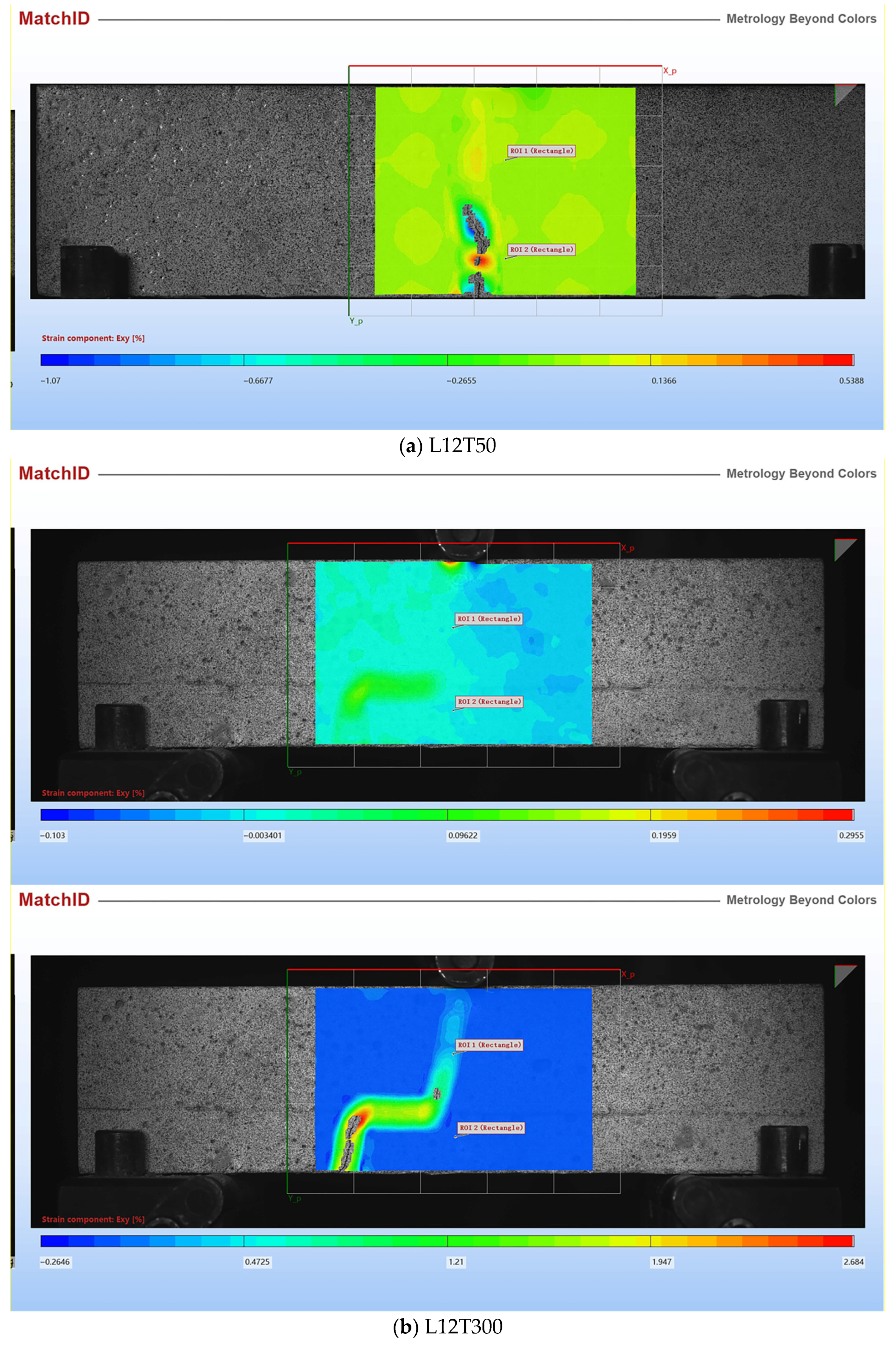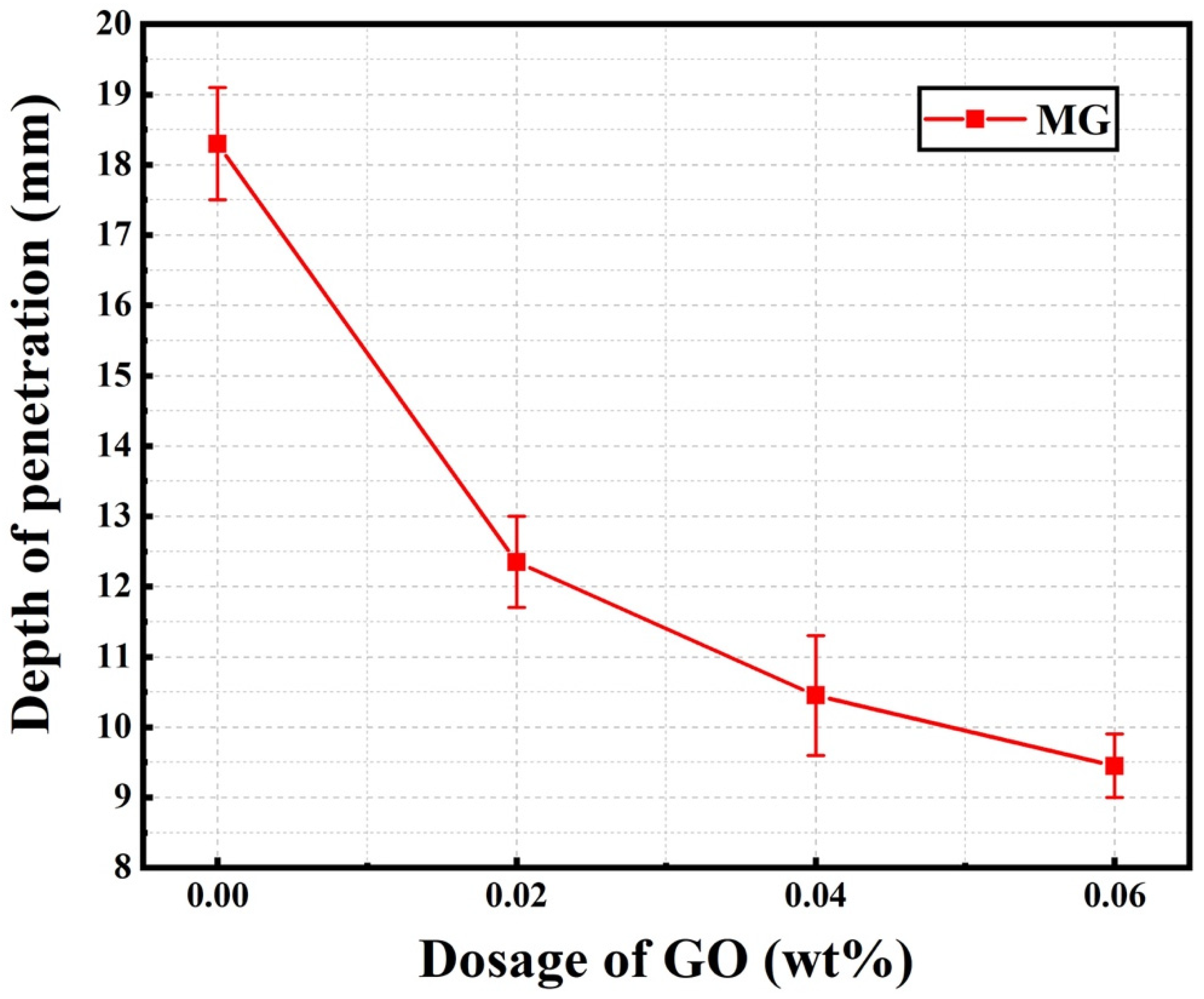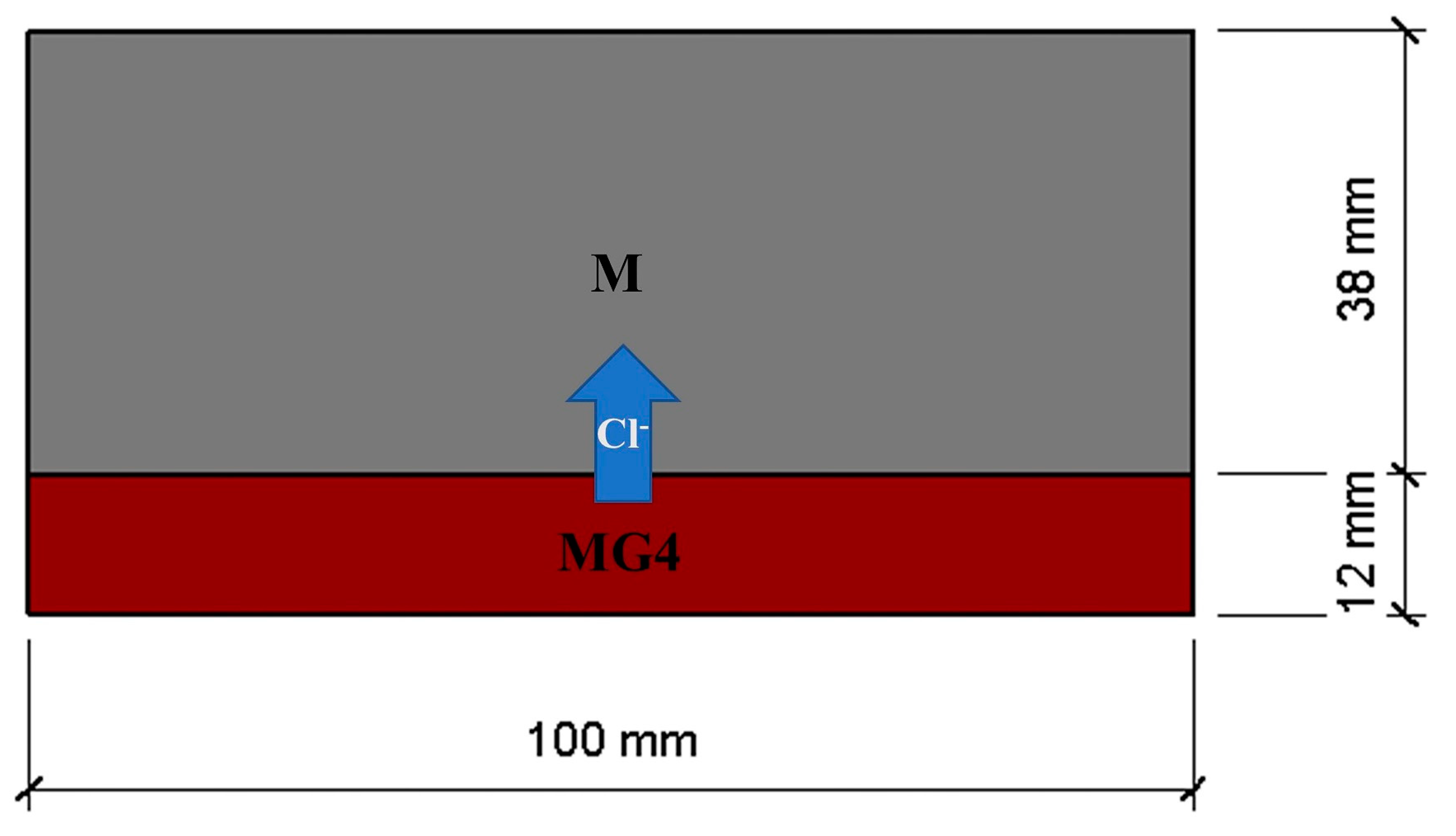Efficient Use of Graphene Oxide in Layered Cement Mortar
Abstract
:1. Introduction
2. Experimental
2.1. Materials
2.2. Preparation of GO Incorporated Cement Mortar
2.3. Fabrication of Layered Cement Mortar Beams with Graded Distribution of GO
2.4. Mechanical Tests
2.5. SEM
2.6. Rapid Chloride Migration (RCM) Test
3. Results and Discussions
3.1. Microstructure of Cement Mortar Samples
3.2. Observations of Layer-to-Layer Interface
3.3. Flexural and Compressive Strengths
3.4. Flexural Failure Characteristics of Layered Cement Mortar Beams
3.5. Chloride Migration Coefficients of Layered Cement Mortar
4. Conclusions
- (1)
- The graded distribution of GO in cement composites could be achieved by casting a fresh GO-incorporated cement layer on another layer. For samples with a specified thickness of the GO-incorporated cement layer, the optimal delay time between sequential castings was determined by analyzing the flexural strength;
- (2)
- When the GO was added in the tensile region only, the mechanical properties of the layered cement mortar beams were not compromised compared to those of the control sample. However, the interface formed between the layers significantly influenced the mechanical properties. Measures to improve interfacial adhesion should be investigated in future studies;
- (3)
- The RCM test results showed that a small amount of GO could significantly slow down chloride ingress. This effect was more pronounced when the dosage or aspect ratio of the GO was increased. The mechanism was that, as a physical barrier, GO nanosheets increased the tortuosity of the cement matrix and immobilized the migration of water and chloride ions through chemical bonding.
Author Contributions
Funding
Institutional Review Board Statement
Informed Consent Statement
Data Availability Statement
Acknowledgments
Conflicts of Interest
References
- Choi, Y.; Yuan, R.L. Experimental relationship between splitting tensile strength and compressive strength of GFRC and PFRC. Cem. Concr. Res. 2005, 35, 1587–1591. [Google Scholar] [CrossRef]
- Yu, R.; Spiesz, P.; Brouwers, H.J.H. Effect of nano-silica on the hydration and microstructure development of Ultra-High Performance Concrete (UHPC) with a low binder amount. Constr. Build. Mater. 2014, 65, 140–150. [Google Scholar] [CrossRef] [Green Version]
- Rossen, J.E.; Lothenbach, B.; Scrivener, K.L. Composition of C–S–H in pastes with increasing levels of silica fume addition. Cem. Concr. Res. 2015, 75, 14–22. [Google Scholar] [CrossRef] [Green Version]
- Parveen, S.; Rana, S.; Fangueiro, R.; Paiva, M.C. Microstructure and mechanical properties of carbon nanotube reinforced cementitious composites developed using a novel dispersion technique. Cem. Concr. Res. 2015, 73, 215–227. [Google Scholar] [CrossRef]
- Zhao, L.; Guo, X.L.; Song, L.G.; Dai, G.; Liu, J. An intensive review on the role of graphene oxide in cement-based materials. Constr. Build. Mater. 2020, 241, 117939. [Google Scholar] [CrossRef]
- Wang, Y.; Yang, J.; Dong, O. Effect of graphene oxide on mechanical properties of cement mortar and its strengthening mechanism. J. Mater. 2019, 12, 3753. [Google Scholar] [CrossRef] [PubMed] [Green Version]
- Qi, X.; Zhang, S.; Wang, T.; Guo, S.; Ren, R. Effect of high-dispersible graphene on the strength and durability of cement mortars. J. Mater. 2021, 14, 915. [Google Scholar] [CrossRef] [PubMed]
- Zeng, H.; Lai, Y.; Qu, S.; Yu, F. Effect of graphene oxide on permeability of cement materials: An experimental and theoretical perspective. J. Build. Eng. 2021, 41, 102326. [Google Scholar] [CrossRef]
- Liu, C.J.; Huang, X.C.; Wu, Y.Y.; Deng, X.; Zheng, Z. The effect of graphene oxide on the mechanical properties, impermeability and corrosion resistance of cement mortar containing mineral admixtures. Constr. Build. Mater. 2021, 288, 123059. [Google Scholar] [CrossRef]
- Pan, Z.; He, L.; Qiu, L.; Korayem, A.H.; Li, G.; Zhu, J.W.; Collins, F.; Li, D.; Duan, W.H.; Wang, M.C. Mechanical properties and microstructure of a graphene oxide–cement composite. Cem. Concr. Comp. 2015, 58, 140–147. [Google Scholar] [CrossRef]
- Lu, Z.Y.; Hanif, A.; Ning, C.; Shao, H.; Yin, R.; Li, Z. Steric stabilization of graphene oxide in alkaline cementitious solutions: Mechanical enhancement of cement composite. Mater. Design 2017, 127, 154–161. [Google Scholar] [CrossRef]
- Lv, S.; Zhang, J.; Zhu, L.; Jia, C. Preparation of cement composites with ordered microstructures via doping with graphene oxide nanosheets and an investigation of their strength and durability. Materials 2016, 9, 924. [Google Scholar] [CrossRef] [PubMed] [Green Version]
- Tong, T.; Fan, Z.; Liu, Q.; Wang, S.; Tan, S.; Yu, Q. Investigation of the effects of graphene and graphene oxide nanoplatelets on the micro-and macro-properties of cementitious materials. Constr. Build. Mater. 2016, 106, 102–114. [Google Scholar] [CrossRef]
- Devi, S.C.; Khan, R.A. Compressive strength and durability behavior of graphene oxide reinforced concrete composites containing recycled concrete aggregate. J. Build. Eng. 2020, 32, 101800. [Google Scholar] [CrossRef]
- Indukuri, C.S.R.; Nerella, R. Enhanced transport properties of graphene oxide based cement composite material. J. Build. Eng. 2021, 37, 102174. [Google Scholar] [CrossRef]
- Shen, B.; Hubler, M.; Paulino, G.H.; Struble, L.J. Functionally-graded fiber-reinforced cement composite: Processing, microstructure, and properties. Cem. Concr. Comp. 2008, 30, 663–673. [Google Scholar] [CrossRef]
- Wen, X.D.; Tu, J.L.; Gan, W.Z. Durability protection of the functionally graded structure concrete in the splash zone. Constr. Build. Mater. 2013, 41, 246–251. [Google Scholar] [CrossRef]
- Choudhary, S.; Chaudhary, S.; Jain, A.; Gupta, R. Assessment of effect of rubber tyre fiber on functionally graded concrete. J. Mater. Today Proc. 2020, 28, 1496–1502. [Google Scholar] [CrossRef]
- Shao, R.; Wu, C.; Liu, Z.; Su, Y.; Liu, J.; Chen, G.; Xu, S. Penetration resistance of ultra-high-strength concrete protected with layers of high-toughness and lightweight energy absorption materials. J. Compos. Struct. 2018, 185, 807–820. [Google Scholar] [CrossRef]
- Cao, Y.Y.; Li, P.P.; Brouwers, H.J.H.; Yu, Q.L. Resistance of multi-layered UHPFRC against in-service projectile: Experimental investigation and modelling prediction. J. Compos. Struct. 2020, 244, 112295. [Google Scholar] [CrossRef]
- Vatin, N. Modified falling mass impact test performance on functionally graded two stage aggregate fibrous concrete. J. Mater. 2021, 14, 5833. [Google Scholar] [CrossRef]
- Panda, B.; Mohamed, N.; Paul, S.C.; Bhagath Singh, G.V.P.; Tan, M.J.; Šavija, B. The effect of material fresh properties and process parameters on buildability and interlayer adhesion of 3D printed concrete. J. Mater. 2019, 12, 2149. [Google Scholar] [CrossRef] [PubMed] [Green Version]
- Xiao, J.Z.; Ji, G.C.; Zhang, Y.M.; Ma, G.; Mechtcherine, V.; Pan, J.; Wang, L.; Ding, T.; Duan, Z.; Du, S. Large-scale 3D printing concrete technology: Current status and future opportunities. Cem. Concr. Comp. 2021, 122, 104115. [Google Scholar] [CrossRef]
- Herrmann, M.; Sobek, W. Functionally graded concrete—Numerical design methods and experimental tests of mass-optimised structural components. Struct. Concr. 2016, 18, 54–66. [Google Scholar] [CrossRef]
- Torelli, G.; Fernández, M.G.; Lees, J.M. Functionally graded concrete: Design objectives, production techniques and analysis methods for layered and continuously graded elements. Constr. Build. Mater. 2020, 242, 118040. [Google Scholar] [CrossRef]
- Wangler, T.P.; Roussel, N.; Bos, F.P.; Salet, T.A.; Flatt, R.J. Digital concrete: A review. Cem. Concr. Res. 2019, 123, 105780. [Google Scholar] [CrossRef]
- Geng, Z.F.; She, W.; Zuo, W.Q.; Lyu, K.; Pan, H.; Zhang, Y.; Miao, C. Layer-interface properties in 3D printed concrete: Dual hierarchical structure and micromechanical characterization. Cem. Concr. Res. 2020, 138, 106220. [Google Scholar] [CrossRef]
- Torelli, G.; Lees, J.M. Interface bond strength of lightweight low-cement functionally layered concrete elements. Constr. Build. Mater. 2020, 249, 118614. [Google Scholar] [CrossRef]
- Brault, A.; Lees, J.M. Wet casting of multiple mix horizontally layered concrete elements. Constr. Build. Mater. 2020, 247, 118514. [Google Scholar] [CrossRef]
- Roussel, N.; Cussigh, F. Distinct-layer casting of SCC: The mechanical consequences of thixotropy. Cem. Concr. Res. 2008, 38, 624–632. [Google Scholar] [CrossRef]
- Li, X.; Lu, Z.; Chuah, S.; Li, W.; Liu, Y.; Duan, W.H.; Li, Z. Effects of graphene oxide aggregates on hydration degree, sorptivity, and tensile splitting strength of cement paste. Comp Part A 2017, 100, 1–8. [Google Scholar] [CrossRef]
- Graphenea. 2006. Available online: http://www.graphenea.com/ (accessed on 8 February 2022).
- Wang, Y.N.; Li, X.; Chen, Y.; Liu, Z. Dispersion of graphene oxide in saturated Ca(OH)2 solution by using different water-reducing agents. J. Phys. Confer. Ser. 2021, 1750, 012063. [Google Scholar] [CrossRef]
- Li, X.Y.; Liu, Y.M.; Li, W.G.; Li, C.Y.; Sanjayan, J.G.; Duan, W.H.; Li, Z. Effects of graphene oxide agglomerates on workability, hydration, microstructure and compressive strength of cement paste. Constr. Build. Mater. 2017, 145, 402–410. [Google Scholar] [CrossRef]
- Li, X.Y.; Li, C.Y.; Liu, J.; Chen, S.J.; Wang, C.M.; Sanjayan, J.G.; Duan, W.H. Improvement of mechanical properties by incorporating graphene oxide into cement mortar. Mechanic. Adv. Mater. Struct. 2018, 25, 1313–1322. [Google Scholar] [CrossRef]
- Zhao, K.Y.; Qiao, Y.; Zhang, P.; Bao, T.; Tian, Y. Experimental and numerical study on chloride transport in cement mortar during drying process. Constr. Build. Mater. 2020, 258, 119655. [Google Scholar] [CrossRef]
- Liu, J.; Wang, X.D.; Qiu, Q.; Ou, G.; Xing, F. Understanding the effect of curing age on the chloride resistance of fly ash blended concrete by rapid chloride migration test. Mater. Chem. Phys. 2017, 196, 315–323. [Google Scholar] [CrossRef]
- Dalgleish, B.J.; Pratt, P.L.; Moss, R.I. Preparation techniques and the microscopical examination of portland cement paste and C3S. Cem. Concr. Res. 1980, 10, 665–676. [Google Scholar] [CrossRef]
- Torelli, G.; Lees, J.M. Fresh state stability of vertical layers of concrete. Cem. Concr. Res. 2019, 120, 227–243. [Google Scholar] [CrossRef]
- Li, Q.H.; Xu, S.L. Experimental investigation and analysis on flexural performance of functionally graded composite beam crack-controlled by ultrahigh toughness cementitious composites. Sci. China Ser. E Technol. Sci. 2009, 52, 1648–1664. [Google Scholar] [CrossRef]
- Liu, X.Z.; Yan, M.P.; Galobardes, I.; Sikora, K. Assessing the potential of functionally graded concrete using fibre reinforced and recycled aggregate concrete. Constr. Build. Mater. 2018, 171, 793–801. [Google Scholar] [CrossRef]
- Maalej, M.; Ahmed, S.F.U.; Paramasivam, P. Corrosion durability and structural response of functionally-graded concrete beams. J. Adv. Concr. Technol. 2003, 1, 307–316. [Google Scholar] [CrossRef] [Green Version]
- Zhang, J.; Wang, Z.B.; Ju, X.; Shi, Z. Simulation of flexural performance of layered ECC-concrete composite beam with fracture mechanics model. Eng. Fract. Mechanic. 2014, 131, 419–438. [Google Scholar] [CrossRef]
- Guan, Z. Study on flexural performance of partial steel fiber reinforced concrete beams. J. Eng. Constr. 2009, 41, 7–10. (In Chinese) [Google Scholar] [CrossRef]
- Qin, R.; Hao, H.; Rousakis, T.; Lau, D. Effect of shrinkage reducing admixture on new-to-old concrete interface. Compo. Part B 2019, 167, 346–355. [Google Scholar] [CrossRef]
- Du, H.J.; Pang, S.D. Enhancement of barrier properties of cement mortar with graphene nanoplatelet. Cem. Concr. Res. 2015, 76, 10–19. [Google Scholar] [CrossRef]
- Andrade, C.; Dez, J.M.; Alonso, C. Mathematical modeling of a concrete surface “skin effect” on diffusion in chloride contaminated media. Advan. Cem. Based. Mater. 1997, 6, 39–44. [Google Scholar] [CrossRef]
- Guo, Y.Q.; Zhang, T.S.; Du, J.P.; Wang, C.; Wei, J.; Yu, Q. Evaluating the chloride diffusion coefficient of cement mortars based on the tortuosity of pore structurally-designed cement pastes. Micro. Mesop. Mater. 2021, 317, 111018. [Google Scholar] [CrossRef]
- Nielsen, L.E. Models for the permeability of filled polymer systems. J. Macromol. Sci. Part A 1967, 1, 929–942. [Google Scholar] [CrossRef]
- Mokhtar, M.M.; Abo-El-Enein, S.A.; Hassaan, M.Y.; Morsy, M.S.; Khalil, M.H. Mechanical performance, pore structure and micro-structural characteristics of graphene oxide nano platelets reinforced cement. Constr. Build. Mater. 2017, 138, 333–339. [Google Scholar] [CrossRef]
- Mohammed, A.; Sanjayan, J.G.; Duan, W.H.; Nazari, A. Incorporating graphene oxide in cement composites: A study of transport properties. Constr. Build. Mater. 2015, 84, 341–347. [Google Scholar] [CrossRef]
- Chang, H.L. Chloride binding capacity of pastes influenced by carbonation under three conditions. Cem. Concr. Comp. 2017, 84, 1–9. [Google Scholar] [CrossRef]
- Mohammed, A.; Sanjayan, J.G.; Nazari, A.; Al-Saadi, N.T.K. The role of graphene oxide in limited long-term carbonation of cement-based matrix. Constr. Build. Mater. 2018, 168, 858–866. [Google Scholar] [CrossRef]
- Zhao, L.; Hou, D.S.; Wang, P.; Guo, X.; Zhang, Y.; Liu, J.; Zhang, J. Experimental and molecular dynamics studies on the durability of sustainable cement-based composites: Reinforced by graphene. Constr. Build. Mater. 2020, 257, 119566. [Google Scholar] [CrossRef]















| Element | Carbon | Oxygen | Hydrogen | Nitrogen | Sulfur |
|---|---|---|---|---|---|
| % | 49–56 | 41–50 | 0–1 | 0–1 | 0–2 |
| Delay Time (min) | Thickness of MG4 Layer (8 mm) | Thickness of MG4 Layer (12 mm) | Thickness of MG4 Layer (16 mm) |
|---|---|---|---|
| 10 | L8T10 | L12T10 | L16T10 |
| 20 | L8T20 | L12T20 | L16T20 |
| 30 | L8T30 | L12T30 | L16T30 |
| 40 | L8T40 | L12T40 | L16T40 |
| 50 | L8T50 | L12T50 | L16T50 |
| 60 | L8T60 | L12T60 | L16T60 |
| 90 | L8T90 | L12T90 | L16T90 |
| 120 | L8T120 | L12T120 | L16T120 |
| 180 | L8T180 | L12T180 | L16T180 |
| 300 | L8T300 | L12T300 | L16T300 |
| Sample | Water/OPC (by Mass) | Sand/OPC (by Mass) | Thickness of MG (mm) | Delay Time (min) | GO/OPC (%) | SP/OPC (%) |
|---|---|---|---|---|---|---|
| M | 0.4 | 2 | / | / | 0 | 0.11 |
| L8T50 | 0.4 | 2 | 8 | 50 | 0.04 | 0.15 |
| L12T50 | 0.4 | 2 | 12 | 50 | 0.04 | 0.15 |
| L16T50 | 0.4 | 2 | 16 | 50 | 0.04 | 0.15 |
| MG2 | 0.4 | 2 | 50 | / | 0.02 | 0.13 |
| MG4 | 0.4 | 2 | 50 | / | 0.04 | 0.15 |
| MG6 | 0.4 | 2 | 50 | / | 0.06 | 0.21 |
Publisher’s Note: MDPI stays neutral with regard to jurisdictional claims in published maps and institutional affiliations. |
© 2022 by the authors. Licensee MDPI, Basel, Switzerland. This article is an open access article distributed under the terms and conditions of the Creative Commons Attribution (CC BY) license (https://creativecommons.org/licenses/by/4.0/).
Share and Cite
Liu, S.; Lu, F.; Chen, Y.; Dong, B.; Du, H.; Li, X. Efficient Use of Graphene Oxide in Layered Cement Mortar. Materials 2022, 15, 2181. https://doi.org/10.3390/ma15062181
Liu S, Lu F, Chen Y, Dong B, Du H, Li X. Efficient Use of Graphene Oxide in Layered Cement Mortar. Materials. 2022; 15(6):2181. https://doi.org/10.3390/ma15062181
Chicago/Turabian StyleLiu, Shuangshuang, Fenglei Lu, Ya Chen, Biqin Dong, Hongxiu Du, and Xiangyu Li. 2022. "Efficient Use of Graphene Oxide in Layered Cement Mortar" Materials 15, no. 6: 2181. https://doi.org/10.3390/ma15062181





